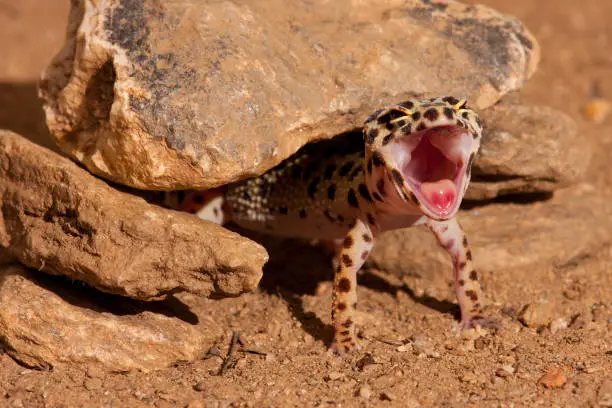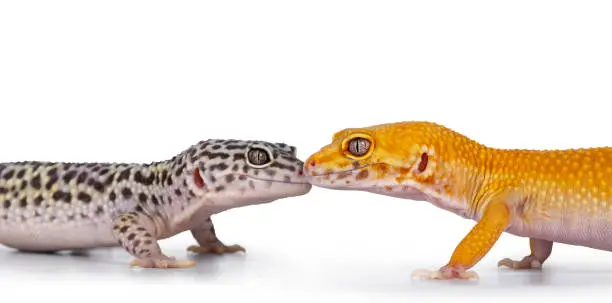I’m getting a leopard gecko and want to know what you think is the best gender. Should I get a male or female leopard gecko for a pet? This is a common question when a beginner wants to make the best choice to avoid having rough edges with the new pet.
When choosing your gecko, consider that male and female leopard geckos are different. They’re as different as male and female humans. There are pros and cons for both genders. But first, I must explain some details about the species itself.
The leopard gecko is a medium-sized lizard typically found in warmer climates. It has an average life span of two to three years. Delving into sex differentiation will generally see you consider some of the following aspects;
- Aggression or temperament
- Dominance or being territorial
- Resilience against illnesses
- Lifespan
- Noise levels
In this article, I will talk about, highlight, and compare some of the above differences between males and females. Then I will talk about how to select which kind of gecko you would like.
In this article
Leopard Gecko Aggression / Temperament Gender Comparison.

We see the same number of aggressive female geckos as aggressive male geckos. However, Leopard gecko’s temperament is based on the individual geckos’ maturity, if feeding, or going through a natural process like ovulation in the case of females.
Male:
Male leopard geckos are more aggressive towards their prey, and they launch at food as if attacking it when feeding. This characteristic may intimidate or even frighten beginners during simple exercises like feeding.
Male geckos mature earlier, which means the aggression associated with maturity will show up earlier in males. They are more active, wanting to come out all the time, and less likely to shy away from people approaching their vivarium than female geckos.
Females:
On the other hand, many female geckos are less aggressive and try to intimidate their prey by shaking or waving their tail. They don’t jump at prey as male geckos but will take time to eat and enjoy their food slowly.
Female geckos are also shy and don’t like being handled, especially during ovulation, unless they’re feeding. If you leave them alone, they’ll usually keep to themselves, but they might come out to play if you’re willing to give them something to eat.
It has also been observed that females often have a drastic temperament change during breeding instead of males that are classified to be consistent. However, males too will be more restless during the breeding as they try to find mating partners.
This means that male geckos are more interactive on a wider scale than female geckos generally laid back and enjoy their company.
What leopard gecko gender can share habitats?
Male:
Male geckos are territorial, and they may fight to the death of one if there is more than one male in the same tank. They bite each other, and their wounds can get infected and cause serious problems.
You won’t be able to house multiple males in one tank, or you’ll have to do pairings with females and possibly multiple tanks for each. However, we don’t recommend housing males with females if you aren’t going to breed them.

Females:
As for housing, female leopard geckos are a better option than male geckos. They’re social and can be housed with other female geckos of equal size, temperament, and age. In a 20 gallon tank, you can usually house two female leopard geckos, and in a 40-gallon tank, you can house 3-4.
If you’re going to enjoy keeping geckos as a hobby, you may find this female advantage appealing. Many people who venture into the hobby of keeping geckos like to have multiple geckos in their tanks.
Leopard Gecko Gender Resilience against Illnesses
Males:
Male leopard geckos have a more predictable eating pattern than female geckos. In good environmental conditions, they seldom fall ill, making them easier and better to have than their female leopard gecko counterpart.
Females:
Female geckos don’t eat during ovulation time and often lose their appetite. As a result of weight loss, they get at an elevated risk of falling sick from various diseases. This will certainly not be enjoyable for many female leopard gecko owners.
Leopard Gecko Gender Lifespan Difference.
Males:
Male Leopard Geckos have fewer health issues and live longer than females. Males are more popular in the pet trade due to their better longevity. Their life spans can vary from 15 to 25 years with proper care.
Females:
On the other hand, the female’s life can span anywhere between 10-15 years old.
Egg production is one of the most stressful events in the life of a female leopard gecko. While producing eggs, they generally only eat 1/3rd or less than usual.
The continuous cycle of egg production, laying the eggs, fasting, and then rinsing out the system every year tends to shorten the lives of female leopard geckos.
Leopard Gecko Chirp Noises Gender Comparison.
Males:
Male geckos use the chirp sounds to signal other geckos of their territory. They increase the volume of their chirps as they feel more threatened by other geckos.
Chirps are also meant to call females for mating.
This means you will have a noisy time with a male Leopard gecko.
Females:
On the other hand, the female leopard geckos only make chirp noises when they get hungry and want to be attended to for feeding. Given the few predictable times they should be feeding, female leopard geckos can easily be considered for more quiet companionship.
Choosing a Leopard Gecko
Both male and female leopard geckos are good pets. Look at their behavior – if they’re not interested in their surroundings and are just swinging their tails and legs, it might mean they’re stressed or have an attitude problem.
Below, however, are summary tips on what to look out for when getting your leopard gecko from a breeder;
- You should check the gecko’s feces for consistency. Healthy gecko’s feces should be dark and in small pellets.
- Leopard geckos should have all their toes present. Missing toes can be a sign of poor living conditions or a shedding problem that was not dealt with properly.
- Leopard geckos’ mouths should be in good condition. They should not have their mouths bulgy or their spines and tails curved.
- The tail should be fat and round. A flat tail can indicate a lack of proper nutrition or intestinal parasites.
- Leopard geckos should have a clean belly and a vent-free of feces.
- If a leopard gecko is too thin, it could signify illness.
So, Should I get a male or female leopard gecko?
The choice is yours. A keen consideration of the above factors and having a personal inclination review will place you at an advantage of making the right choice.

